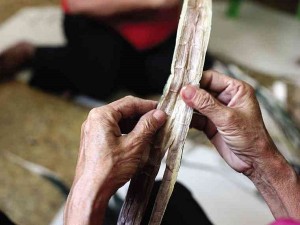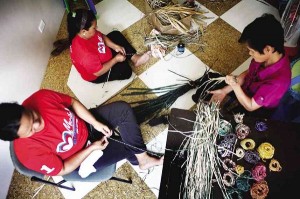Weaving, bonding and nearly drowning: A Pasig success story
It started around Christmas of 2010. Plastic shopping bags were already banned in Pasig City and residents in need of a source of income were taught to weave in a seminar. Then Mayor Bobby Eusebio asked for volunteers to make bayong (woven bags) out of water hyacinths, items which the city government wanted to produce in bulk as giveaways.
It lit a spark of interest among the residents of Barangay San Joaquin. Thick patches of water hyacinths were just blocking the waterways anyway, and the residents were eager to make good use of them. Starting out with simple bayong, the volunteers of Power (Pasigueñas Organization for Women Empowerment and Recognition) eventually learned more intricate designs and produced stylish bags, wallets and home decor.
Three years later, the women have transformed the barangay’s Gender and Development Program (GAD) office into a showroom which proudly displays a queen-size banig (sleeping mat) made of some 2,000 water hyacinth stalks, and other creations. Various plaques of recognition awarded by the Pasig city government attest to the women’s hard work.
“When (the livelihood project) was passed on to me, it became a challenge since I had to find ways to innovate. So I did some research—how to make classier products. So now we have learned how to use dyes and other treatments to keep our products mold-free, for example. We have come up with different designs and even managed to make a gown and barong using water hyacinths,” Kagawad (village councilor) Leyrand Munsod said.
“It’s a (trade) secret,” Munsod said with a smile, referring to their antimold formula. “Even the city officials are asking about it, but it’s our source of pride.”
Article continues after this advertisementThe volunteers set out as early as 5 a.m. to harvest water hyacinths and their favorite spot is along C6 Road facing Laguna de Bay and near the mouth of Pasig River in Taguig City. But there are also times when they just buy the harvested plant from residents along C6.
Article continues after this advertisement“(But) it really feels better when we were the ones harvesting it. There’s fun and bonding. After we harvest, we eat right there along the banks. Even the tiniest stalk of water hyacinth is regarded with much importance because we all know how hard it was to get it,” Munsod said.
Elizabeth Bolos, 64, recalled the day she almost drowned doing it. “I was the one who was always diving in; the others were afraid because the tide was high. You could not tell if your next step would take you deeper. Since I always wanted to get the bigger stalks, I took extra steps, and suddenly I was sinking. Good thing they were able to pull me back quickly.”
Harvested stalks are first boiled to remove the dirt, then dried in the sun for about two weeks. Dyes and chemicals are then applied. Depending on the item to be made, some stalks are flattened and the edges smoothened out before weaving, especially for purses or wallets. Scraps can still be turned into ropes or accents for bigger products like bags or baskets.
There are currently 59 Power volunteers in San Joaquin, most of them plain housewives. They work in shifts but some, like 52-year-old Emma de la Peno, bring the materials home and weave while watching TV.
Japanese buyers
For this project, Barangay San Joaquin earned the Innovative Project Galing Pasig Award in 2012 and Best GAD Practices Award in 2010. In March this year, the village represented Pasig and showcased its water hyacinth products at the Manila Fame International exhibit at Mall of Asia, where it found Japanese buyers.
Other local governments like Barangay Kalawaan (also in Pasig) and Morong town in Rizal province have asked Barangay San Joaquin to teach them the craft.
The project has also attracted customers who could have their choices tailor-made and ready in a week. Wallets can go as low as P25 each, while bags can be had for P150 to P300. Special discounts are given to residents of San Joaquin.
Munsod said the barangay government also came up with a “donate-a-plant” program to better spread word about the products. “We gave away wallets in exchange for every plant” donated to the village. “Many people responded and it was heartwarming.”
The profits are shared among the weavers and harvesters, while a portion goes back to the barangay fund for raw materials.
“Before, we used to hate water hyacinths,” Munsod said. “Now we just love them! For others, they may be a nuisance—but that’s because they have yet to discover their value.”


